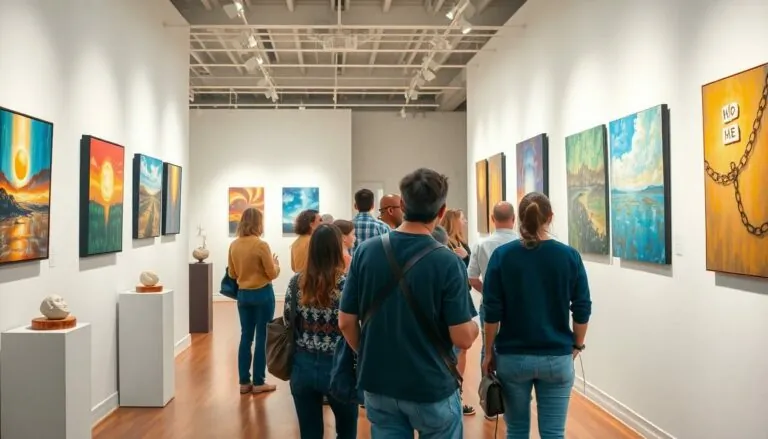Table of Contents
ToggleIn a world overflowing with noise and chaos, modern minimalist art offers a refreshing breath of simplicity. It strips away the unnecessary and invites viewers to engage with the essence of a piece. Think of it as the artistic equivalent of a well-tailored suit—sleek, sophisticated, and effortlessly stylish.
Understanding Modern Minimalist Art
Modern minimalist art emphasizes simplicity, allowing viewers to experience the artwork’s essence. This style strives to eliminate distractions, focusing on essential forms and colors.
Definition and Characteristics
Modern minimalist art defines itself through its focus on simplicity and functionality. Artists use basic geometric shapes, monochromatic palettes, and clean lines. Common characteristics include a lack of embellishments and emphasis on the materials used. This minimalist approach encourages viewers to engage with the artwork on a deeper level, evoking peace and contemplation. Shapes often dominate the canvas, showcasing space and light in innovative ways.
Key Influences and Movements
Key influences on modern minimalist art include De Stijl and Bauhaus movements. De Stijl introduced abstract forms, promoting balance through geometry and primary colors. Bauhaus emphasized craft and design, merging art with everyday life. Additionally, the impact of Japanese aesthetics fosters harmony within minimalism. Artists draw from Eastern philosophy, stressing simplicity, tranquility, and the connection between nature and art. These movements collectively shaped the minimalist art scene, promoting clarity and precision in artistic expression.
Prominent Artists in Modern Minimalist Art
Modern minimalist art features several influential artists known for their significant contributions. These creators illustrate the principles of simplicity and clarity that define this artistic movement.
Notable Works and Contributions
Donald Judd revolutionized minimalist art with his specific use of industrial materials. His works, such as the iconic “Untitled” series, emphasize geometric forms. Agnes Martin’s paintings, characterized by delicate lines and subtle grid patterns, invoke tranquility. Frank Stella focused on the role of color and shape, producing pieces like “Black Series” that challenge traditional boundaries. Dan Flavin explored light as a medium, utilizing fluorescent tubes to create immersive environmental experiences.
Impact on the Art World
The impact of modern minimalist artists reshaped contemporary art perspectives. They encouraged a departure from elaborate narratives, emphasizing viewer interaction with art. This movement influenced architecture, product design, and fashion, promoting a vision centered on functionality and simplicity. The resonance of minimalist principles extends beyond art, affecting everyday aesthetics. Curators and collectors increasingly value minimalist works for their emotional and visual clarity, highlighting their relevance in current artistic dialogues.
The Evolution of Modern Minimalist Art
Modern minimalist art has its roots deeply embedded in various historical contexts.
Historical Context
The emergence of modern minimalist art aligns with several key movements. The De Stijl movement, originating in the early 20th century, introduced geometric abstraction and a focus on pure form. Bauhaus principles further encouraged functionality in design, marrying aesthetic appeal with utility. Artists sought to strip away decorative excess, emphasizing clarity and precision. Minimalism also reflects a reaction against the expressive tendencies of Abstract Expressionism, making simplicity a powerful statement. Notably, Japanese aesthetics influenced Western minimalism, fostering a connection between nature and art. Together, these contexts shaped minimalist approaches, promoting artworks that engage viewers without distraction.
Contemporary Trends
Contemporary minimalist art reflects ongoing cultural shifts and innovations. Artists increasingly explore the boundaries of space and material, creating immersive installations and interactive experiences. The use of technology in art has gained prominence, allowing minimalist works to incorporate light, sound, and audience participation. Sustainability stands as a significant trend, with creators using recycled materials to echo minimalist values while addressing environmental concerns. Social commentary often intertwines with minimalist aesthetics, prompting viewers to reflect on consumerism and simplicity. Embracing these developments ensures that modern minimalist art remains relevant and thought-provoking in today’s diverse artistic landscape.
The Role of Space and Material
Modern minimalist art relies heavily on the strategic use of space and material, shaping its distinctive aesthetic. It emphasizes simplicity, often making empty space integral to the composition. This intentional spacing enhances the viewer’s focus on the artwork’s core elements, creating a sense of balance and calm.
Use of Color and Form
Color and form play crucial roles in conveying the essence of minimalist art. Artists frequently utilize monochromatic palettes to eliminate distractions. Geometric shapes dominate compositions, focusing on clarity over complexity. Each color choice reinforces emotional responses while maintaining visual harmony. The combination of limited color and basic forms allows for a profound exploration of the artwork’s fundamental attributes.
Interaction with the Viewer
Viewer interaction remains central to modern minimalist art. Artwork invites contemplation, encouraging personal interpretation. This engagement fosters a deeper connection to the piece, transforming passive observation into active participation. Spatial arrangements prompt viewers to move around the artwork, offering diverse perspectives. Minimalism’s simplicity facilitates a unique dialogue between the viewer and the art itself, enriching the overall experience.
Modern minimalist art stands as a powerful testament to the beauty of simplicity. By stripping away the superfluous it invites viewers to engage deeply with the essence of each piece. This art form not only reflects a reaction to complexity in contemporary life but also fosters a sense of peace and contemplation.
The influence of historical movements and cultural shifts ensures that minimalist art remains dynamic and relevant. Through the use of space color and form artists create an immersive experience that transcends mere observation. As society continues to evolve the principles of modern minimalist art will undoubtedly inspire future generations to explore the profound impact of simplicity in their own creative expressions.







